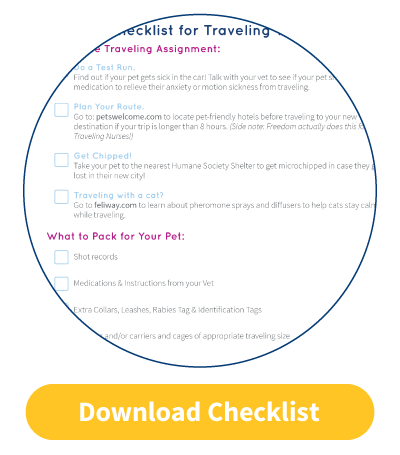Severe weather can be both frightening and dangerous for automobile travel. Traveling Nurses are on the road often and when it comes to winter weather, everyone needs to be prepared. Drivers are facing a many challenges when inclement weather starts to hit. More than 116,000 Americans are injured and over 1,300 are killed on snowy, slushy or icy pavement every winter. For a safer winter driving experience, take the time to prepare your car beforehand, know the forecast and drive according to road conditions. Below are some winter driving safety tips to help you buckle up for the cold weather ahead.
Prepare Your Vehicle
As temperatures drop, you will need to stock a winter survival kit. A simple kit includes:
- An ice scraper
- A snow shovel
- Sand or salt
- A Flashlight
- A few blankets
Do you have a winter survival kit in your car? Include these items to tackle winter slopes: Click To Tweet Be prepared for any situation with our handy first day checklist!
Keep this kit in your car at all times so you’ll be prepared if a storm hits while you’re traveling to your next assignment. It’s also a good time to check your tires. It might be time for replacement. You may even want to consider investing in all-season tires. It’s always great to get back into useful habits with your car during the winter months. Keep your gas tank at least half full so you can run your engine and stay warm if you get stranded. This is also important for the health of your fuel line. Keep your windshield wipers in good condition and check all your fluids. These steps can save you big bucks in the long run.
Watching the Weather
If you plan to travel to your next assignment during the winter months, be sure to monitor road and weather conditions online and with local news affiliates. You can also download one of the four best weather apps suggested by Storm Geeks here. Please do not check your phone while driving, and avoid all unnecessary distractions when you’re behind the wheel. If you're out traveling on the winter roads often, download these four amazing weather apps: Click To Tweet
Driving for Winter Conditions
Before you start heading to your next travel assignment, take time to clear all the snow and ice off your car, including your windows, mirrors, lights, reflectors, hood, roof and trunk. Drive with your headlights on, and be sure to keep them clean to improve visibility. Use caution when snow limits your view of oncoming traffic. As you start your journey, remember that speed limits are meant for dry roads, not roads covered in snow and ice. Interstate and highway speeds are reduced by 3% to 13% in light snow and by 5% to 40% in heavy snow, according to the US Dept. of Transportation. Avoid using cruise control in snowy or icy conditions, so you have as much control of your car as possible. Be cautious on bridges and overpasses as they are usually the first areas to become icy.
Breaking Down or Getting Stuck
If you are unexpectedly caught in a storm and encounter issues, be sure your car is safely out of harm’s way and call for help. Take the following steps to ensure your own safety while waiting for an emergency response:
- Keep your seatbelt on and put on your hazard lights. If visibility is low and roads are slick, people might not see your car or hit you.
- Immediately check to see that the exterior exhaust on the car is clear of snow. You don’t want carbon monoxide buildup in the car!
- Turn the car off. You can turn it back on every once in awhile to heat up the interior, but leaving it on too long could run out the gas. Be sure to check the tailpipe each time.
- Keep moving. Doing various exercises, like pushups or flutter kicks will keep you warm without the use of gas.
- Stay hydrated. If you don’t have water in the car, you will need to melt snow. The more hydrated you are, the warmer you will be.
Remember, driving in winter weather can be challenging for even the most experienced drivers and we want you to be safe when you are traveling to your assignments. Slowing down, wearing your seatbelt, devoting your full attention to the road and being aware of changing conditions will help you drive more safely. If you’re going to experience bad weather, please call your recruiter so we can account for the delay. We would rather you be safe than run into any issues while on the road. Wondering what your next assignment could be? Check out a list of available jobs at Freedom Healthcare here.
